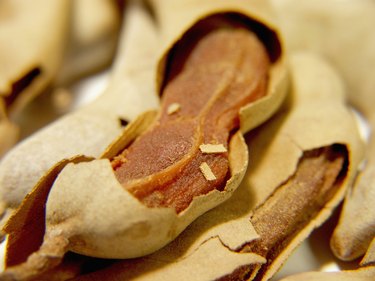
Dried tamarind looks something like a sugarplum, hinting at a food best reserved for the dessert table. Tamarind's complex sweet and sour taste, however, give this African native fruit culinary uses that range from steak sauce to chutney to cocktails. Like other acidic fruits, tamarind can also tenderize meat when used in a marinade. Among the forms in which you'll find tamarind is as a concentrated paste and as a puree.
Tamarind Paste
Video of the Day
Tamarind paste comes in two forms. The first is a super-compressed brick of dried tamarind pods. Similar in color and texture to fig paste, tamarind paste contains the pods and seeds of the dried fruit. This brick form is quite compressed and must be soaked before you can use it. The second form of tamarind paste is more of a ready-to-use product, with some of the pods and seeds removed. Sold in jars, this paste is known as either tamarind concentrate or jarred tamarind paste.
Video of the Day
Tamarind Puree
Tamarind puree is a more fluid form of tamarind, and also made from the dried form of the fruit. In thickness, tamarind puree is more like dipping sauce or apple butter in texture, compared to the extremely compressed form of solid or jarred concentrate. You can purchase ready-made sweetened puree in jars, or make it at home. Homemade puree starts by soaking dried pods or paste bricks overnight, separating the pods and the seeds from the pulp by forcing tamarind through a colander lined with cheesecloth, and combining the pulp with the soaking liquid.
Cooking with Tamarind Paste
For ease of preparation, look for tamarind paste in a jar, so that it can be easily blended with other ingredients without the need to pre-soak it. A few tablespoons of tamarind paste in this ready-to-use form can be mixed with honey and a chili-garlic sauce to glaze lamb or chicken before heating or grilling. The concentrate is also an ingredient in tart frozen desserts and in cocktails. Mixed with lime juice, syrup and bourbon, then poured over ice, tamarind paste concentrate gives an exotic touch to a the traditional whiskey sour.
Tamarind Puree Methods
Jarred tamarind puree adds rich color and a sweet-sour taste to sauces for stir-fries and curries, among other dishes. Mix it with water and soy sauce at a rate of 4 parts soy sauce to 2 parts water and 1 part tamarind puree, adding it to a stir-fry of rice, vegetables, fish or soy protein in the last 30 seconds of the cooking process. In a fish curry, 1 teaspoon of tamarind puree joins spices and chili paste in a coconut milk-tomato sauce.